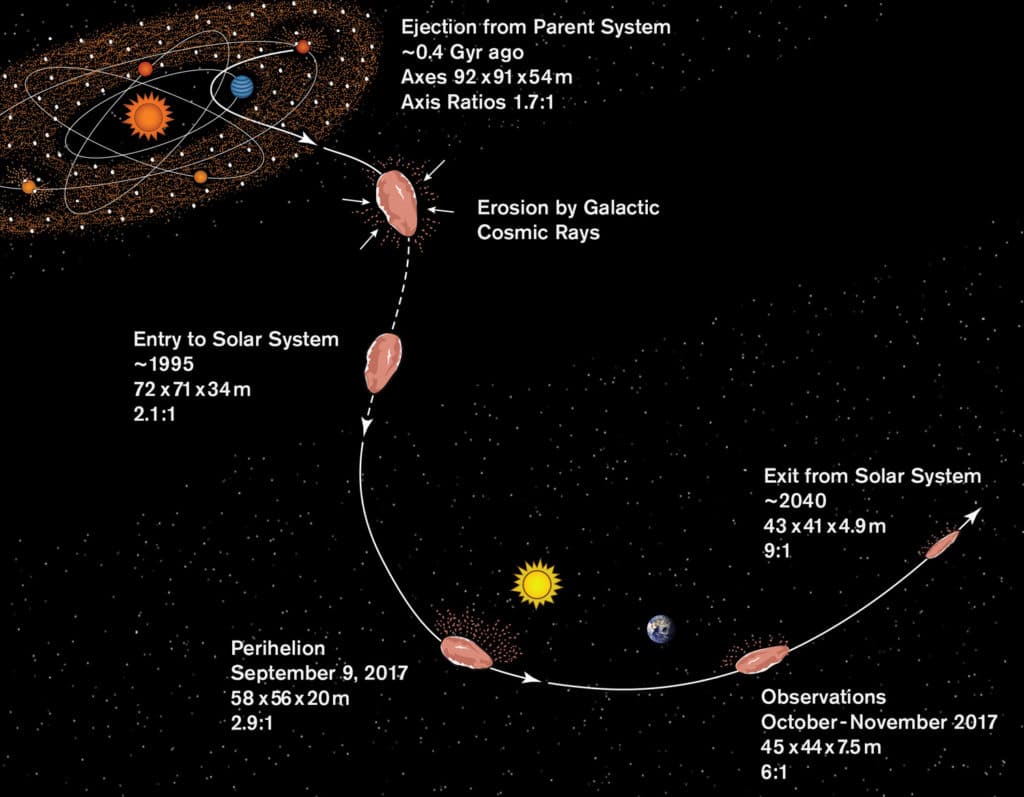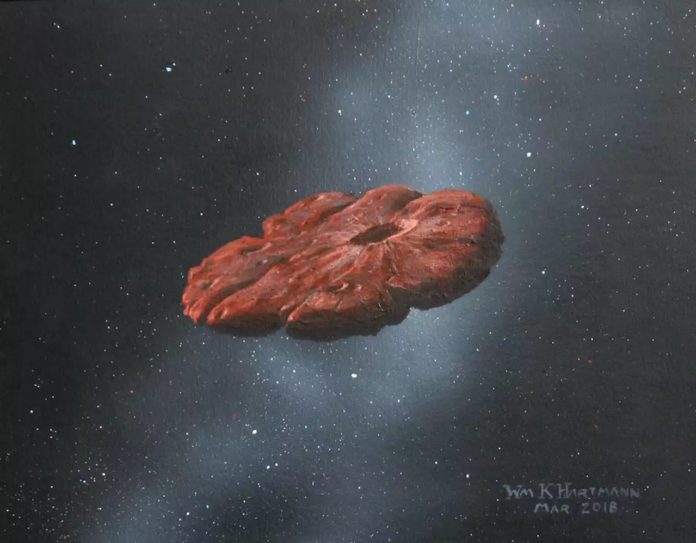In 2017, astronomers discovered the first known interstellar object to visit our solar system. The object called Oumuamua is very strange, and it is hard to explain where it came from.
The object was originally classified as a comet, but observations revealed no signs of cometary activity after it slingshotted past the Sun at a speed of 196,000 miles per hour.
Astrophysicists from Arizona State University recently come up with an explanation on the features of ‘Oumuamua. They likely have determined its origin.
They found that this interstellar object is likely a piece of a Pluto-like planet from another solar system.
Steven Desch of the School of Earth and Space Exploration said, “In many ways’ Oumuamua resembled a comet, but it was peculiar enough in several ways that mystery surrounded its nature, and speculation ran rampant about what it was.”

Astrophysicists determined several characteristics of the object, including its speed, size, composition, etc. They found that the object entered the solar system at a velocity a bit lower than would be expected, indicating that it had not been traveling in interstellar space for more than a billion years or so. Its pancake shape was also more flattened than any other known solar system object in terms of size.
They also observed that while the object acquired a slight push away from the sun. The object was made of different ices when it comes to its composition, but it lacked a detectable escaping gas by a comet’s tail.
In all, the object resembles a comet, but unlike any comet that had ever been observed in the solar system.
Desch, along with Alan Jackson of the School of Earth and Space Exploration, calculated how the ices would sublimate as the object acquired the push by the sun. They calculated the rocket effect, the object’s mass and shape, and the ices’ reflectivity.
Desch said, “That was an exciting moment for us. We realized that a chunk of ice would be much more reflective than people were assuming, which meant it could be smaller. The same rocket effect would then give ‘Oumuamua a bigger push, bigger than comets usually experience.”
“One ice in particular — solid nitrogen — that provided an exact match to all the object’s features simultaneously. And since solid nitrogen ice can be seen on the surface of Pluto, it is possible that a cometlike object could be made of the same material.”
“We knew we had hit on the right idea when we completed the calculation for what albedo (how reflective the body is) would make the motion of ‘Oumuamua match the observations. That value came out as being the same as we observe on the surface of Pluto or Triton, bodies covered in nitrogen ice.”
Scientists likewise determined the rate at which chunks of solid nitrogen ice would have been knocked off Pluto’s surfaces and comparable bodies. What’s more, they determined the likelihood that chunks of solid nitrogen ice from other universes would reach us.
Jackson said, “It was likely knocked off the surface by an impact about half a billion years ago and thrown out of its parent system. Being made of frozen nitrogen also explains the unusual shape of ‘Oumuamua. As the outer layers of nitrogen ice evaporated, the shape of the body would have become progressively more flattened, just like a bar of soap does as the outer layers get rubbed off through use.”
Desch said, “Everybody is interested in aliens, and it was inevitable that this first object outside the solar system would make people think of aliens. But it’s important in science not to jump to conclusions. It took two or three years to figure out a natural explanation — a chunk of nitrogen ice — that matches everything we know about ‘Oumuamua. That’s not that long in science, and far too soon to say we had exhausted all natural explanations.”
There is no evidence that Oumuamua is alien technology, but it offered scientists a new way to look at extrasolar systems.
Desch said, “This research is exciting in that we’ve probably resolved the mystery of what ‘Oumuamua is, and we can reasonably identify it as a chunk of an ‘exo-Pluto,’ a Pluto-like planet in another solar system. Until now, we’ve had no way to know if other solar systems have Pluto-like planets, but now we have seen a chunk of one pass by Earth.”
Journal References:
- Alan P. Jackson et al. 1I/‘Oumuamua as an N2 ice fragment of an exo‐Pluto surface: I. Size and Compositional Constraints. doi: 10.1029/2020JE006706
- S. J Desch et al. 1I/‘Oumuamua as an N2 ice fragment of an exo‐pluto surface II: Generation of N2 ice fragments and the origin of ‘Oumuamua. doi: 10.1029/2020JE006807
